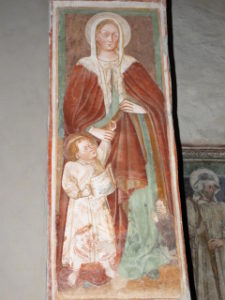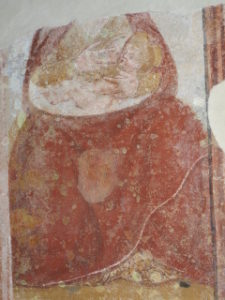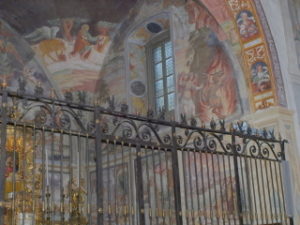The small church of San Michele al Pozzo Bianco, on Via Porta Dipinta, just about 200 metres down the hill from the Piazza Mercato della Scarpe (where the top station of the funicular is located) in Città Alta, Bergamo, without a shadow of a doubt houses the finest collection of en situ Romanesque religious paintings in the city. Covering the period from the early 12th to the late 16th centuries its possible, in this one small building, to get an idea of the evolution not only of the artistic styles but also the way of thinking of the population during that 500 year period. For some reason unknown to me it rarely gets mentioned in any of the tourist material, either on paper or online.
Close to the place where most tourists arrive in Città Alta (the cable railway from the lower town) the San Michele suffers from one major disadvantage in attracting visitors – the walk down is not so much of a problem but the walk up is. That means that on all the occasions I've been there I have mostly had the place to myself. Contrast this to the Duomo or the Santa Maria Maggiore where, if you arrive at the wrong time, there may be large group after an even larger group of organised and guided Italian children or pensioners as well as groups brought to Bergamo by the major foreign tour companies who are 'doing' the city in a day.
Unfortunately all of them are missing out on a little gem but if you make the effort to go down the hill you'll be rewarded by a peaceful and quiet art gallery where you can take your time, quietly taking in the frescoes, in the cool of one of the oldest structures in Città Alta.
It's on record that there was a church of some kind on this spot from as early as 774 AD but it has gone through a number of reincarnations to get where it is now. As tastes changed some of the older frescoes were covered by a new layer of plaster and frescoes painted on that. That wouldn't be such a problem if it was just a matter of covering the old so that they could make way for the new. However, in order to prevent the new layer of plaster just slipping down to the floor the workmen had to key the new plaster to the wall, this meant having to basically destroy (or at least mutilate) the older frescoes and that's way when restoration work uncovers the past they are very often either deeply scratched or pitted where the hammer has made an anchor point for the new layer.
So there's an element of evolution of styles and the way of telling the Bible story. Personally I have come to like the older, more naïve frescoes. They are primitive, lack perspective very often but tell a better story. In the San Michele church some of the oldest to be seen are on the back wall of the nave where you'll find depictions of the serpent tempting Eve with the forbidden fruit and the Damned chained together being taken by the Devil's servants to spend eternity paying for their sins on Earth. One of their number includes a Bishop, with his mitre, thus showing that at the time of the final judgement even the church hierarchy will not be immune.
At a time when the church was all-powerful and dominated the lives of the ordinary people I like the way that the local artists were allowed to make such statements in the very places that the priests would have been preaching. The fact that few of them changed their ways even with these images directly in front of them everyday just goes to show their hypocrisy in peddling the myths upon the vast majority of the population.
It's this literal interpretation of the Bible story that I find quite charming, made by artists who probably DID believe in what they were being told for a congregation that DID fear what would befall them after death.
In places, in both the nave and in the crypt downstairs, the restoration process has taken the plaster back to the original but also decisions have been made to preserve some of the later works if they had been considered worthy of preservation. Where the different periods meet can be seen directly in front of you when reaching the bottom steps into the crypt, the remains of the 13th century pictures being seen next to those from the 15th. To the right of that alcove an earlier marble pillar, from the original structure has also been uncovered.
In the crypt, in a fresco that dates from around the 15th century, is something I've never seen before and that's a Saint wearing spectacles. There's no reason why he shouldn't, I just find it quaint.
It would take too long in mentioning all the different frescoes around the walls suffice it to say that in its heyday this small church must have been very colourful indeed, especially when the paintings were new and before time had faded them.
However, there a some aspects of the decoration that merit special mention.
The chapel to the left of the altar was painted by Lorenzo Lotto in 1525, the final year of his more than 10 year stay in Bergamo. The main theme is the 'life' of the Virgin, from her birth, through her presentation at the Temple to her marriage to Joseph. These frescoes are more naturalistic than many of those which exist in the nave and the crypt and are a product of the Renaissance. Lotto was a contemporary of Titian but Giorgio Vasari (who is remembered today principally for his book Lives of the Most Excellent Painters, Sculptors and Architects) didn't think that the two were on a par and devoted little time to Lotto in his book on art history. An article I read about Lotto suggested that this might have been that Lotto wasn't any good at painting nudes, either male or female, an interesting take on how an artist attains fame.
Whatever Vasari might have thought Bergamo proclaims Lotto, not only for his work in San Michele but also for the altarpiece from the Church of the Santo Spiritu (just along from the Teatro Donizetti in the new town). At the moment there's a gaping hole on the right hand side of the nave as the painting (the Pala di Santo Spiritu) has just completed a long and expensive renovation. It went on public show in the locale of one of the banks that had funded the restoration on the very afternoon that I left Bergamo so I wasn't able to see it. I assume, however, that in the not too distant future it will return to its original home.
The central chapel was painted by Giovani Battista Guarinoni d'Averara in 1577. There's a lot going on here and some of it is difficult to see as the huge altar gates prevent close inspection. What I like about Guarinoni d'Averara's work is that it seems to be at that point of transition between the Romanesque and the Renaissance, even though he's working quite late.
To illustrate my point have a look at the lion in the top left hand corner, the symbol of Saint Mark, which has an almost human face. On the right hand side of the altar the depiction of the Archangel Michael chasing the Devil and, on the left, God's good angels chasing Lucifer's rebel angels out of Heaven all have reminders of the primitive and literal images that are in other parts of the building.
In the centre of the altar sits the small painting of the Madonna and Child (La Madonna del Buon Consiglio). On the 26th April each year this painting is mounted on a silver frame and paraded around the parish by the Pozzo Bianco Fraternity.
This is a small church but full of things to see and well worth the effort it might take to visit.
Lighting: In the porch, right next to the doorway into the church itself, there's a slot machine where, for different amounts of cents, you can light up parts or even the whole of the nave and crypt. If you arrive on a reasonably bright day there's enough ambient light from the windows to see the majority of the frescoes (although the central altar will still be dim) but without the aid of the paid for light you'll get little appreciation of the paintings in the crypt.
Opening Times: Daily: 09.30 – 12.00 and 15.00 – 18.00
Entrance: Free










